
Super Mario World, known in Japanese marketing as Super Mario World: Super Mario Bros. 4, is a platform game developed by Nintendo EAD and published by Nintendo for the Super Nintendo Entertainment System (SNES). It was released in Japan in 1990, North America in 1991 and Europe and Australia in 1992. The player controls Mario on his quest to save Princess Peach and Dinosaur Land from the series' antagonist Bowser and the Koopalings. The gameplay is similar to that of earlier Super Mario games; players control Mario through a series of levels in which the goal is to reach the goalpost at the end.

Super Mario Land 2: 6 Golden Coins is a 1992 platform game developed and published by Nintendo for the Game Boy. It is the sequel to Super Mario Land. In Super Mario Land 2, the player assumes the role of the protagonist Mario, whose main objective is to reclaim his personal island, Mario Land, from the clutches of his greedy rival Wario. The gameplay builds and expands on that of its precursor with innovations carried over from Super Mario World.
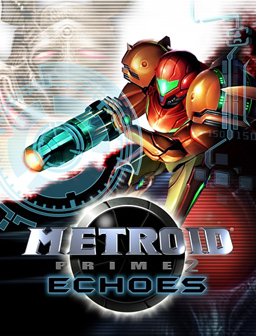
Metroid Prime 2: Echoes is a 2004 action-adventure game developed by Retro Studios and published by Nintendo for the GameCube. The sequel to Metroid Prime (2002) and the first Metroid game with a multiplayer feature, Echoes was released in North America, Europe and Australia in 2004 and in Japan under the name Metroid Prime 2: Dark Echoes in May 2005.

Balloon Fight is an action video game developed by Nintendo and HAL Laboratory and published by Nintendo. The original arcade version was released for the Nintendo VS. System internationally as Vs. Balloon Fight, while its Nintendo Entertainment System counterpart was released in Japan in 1985 and internationally in 1986.

Balloon Kid is a flying platform game developed and published by Nintendo for the Game Boy on October 5, 1990, in North America and on January 31, 1991, in Europe. It is the sequel to Balloon Fight. It was never released in Japan for the original Game Boy; however, two years after its original release, a licensed Family Computer port titled Hello Kitty World was reprogrammed and released by Sanrio's subsidiary Character Soft exclusively in Japan on March 27, 1992. A Game Boy Color edition with a few new features titled Balloon Fight GB was released in Japan on July 31, 2000.

Final Fight 2 is a 1993 side-scrolling beat 'em up video game released by Capcom for the Super Nintendo Entertainment System. It is the direct sequel to the 1989 coin-operated arcade game Final Fight, which was previously also released for the SNES. Final Fight 2 was developed by Capcom's consumer division with no preceding coin-op version. The game was re-released onto Wii's Virtual Console service in 2009 for the North American and European regions.
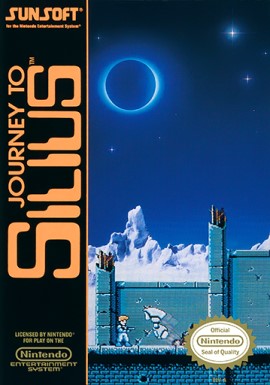
Journey to Silius, known in Japan as Rough World, is a side-scrolling run and gun video game developed and published by Sunsoft for the Nintendo Entertainment System in 1990.

Little Samson is a 1992 platform game developed by Takeru and published by Taito for the Nintendo Entertainment System. It was released in Japan on June 26, 1992, in North America on October 22, 1992, and in Europe on March 18, 1993.

Battle Clash is a 1992 light gun shooter video game developed by Intelligent Systems and published by Nintendo for the Super Nintendo Entertainment System. It is one of several titles that requires the Super Scope light gun. The plot takes place in a futuristic post-apocalyptic Earth, where battles are fought with mechs called Standing Tanks (STs) and the winner takes control of the world. A young man named Mike Anderson participates in the Battle Game to face the ruthless champion Anubis and avenge his father's death. The player acts as the gunner of the ST Falcon piloted by Anderson, taking on Anubis and his subordinate chiefs in one-on-one fights.
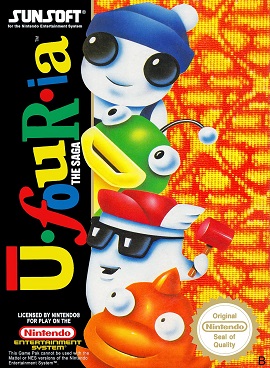
Ufouria: The Saga is a 1991 action-adventure video game developed and published in Japan and Europe by Sunsoft for the Nintendo Entertainment System. It is the first entry in the Hebereke franchise, where almost every installment in the series features a completely different playstyle. Controlling a humanoid-looking character called Bop-Louie through an interconnected world, the game focuses on exploration and searching for items and power-ups in vein of Metroid and Blaster Master, fighting bosses and minibosses. During gameplay, the player locates the main character's three friends, each of which becomes a playable character and have unique skills that allow the player to reach previously inaccessible areas.

Galaxy Fight: Universal Warriors is a fighting game originally developed and published by Sunsoft in 1995 for the Neo-Geo MVS in arcades, and then for the Neo Geo AES console. It was Sunsoft's second fighting game after their 1994 Super Famicom spin-off of their Hebereke series, Sugoi Hebereke, as well as their first side-viewed 2D fighting game.

Virtual Boy Wario Land is a 1995 platform video game developed and published by Nintendo for the Virtual Boy. It stars Wario, who finds himself deep underground after stumbling upon a treasure-filled cave and must find his way back to the surface. Throughout the journey, the player explores and searches for items and power-ups while fighting enemies and defeating bosses. Wario has the ability to jump between the background and foreground at certain points, making use of Virtual Boy's stereoscopic 3D effect.
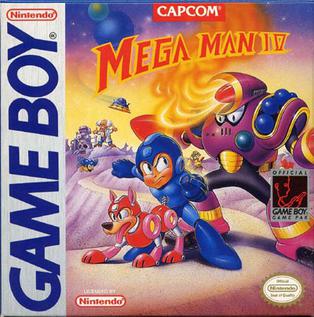
Mega Man IV is an action-platform video game by Capcom for the Nintendo Game Boy. It is the fourth installment in the handheld version of the Mega Man series. The game continues the quest of the protagonist Mega Man in the struggle with his long-time nemesis Dr. Wily, who sends out a disruptive radio signal to cause a rampage, citywide destruction from dormant robots. Mega Man IV features the traditional action platforming gameplay of the prior games while introducing one new feature, the ability to purchase items with power-ups found throughout each stage. As with previous Game Boy releases, the game incorporates gameplay elements and bosses from two sequential Nintendo Entertainment System (NES) games: Mega Man 4 and Mega Man 5. The game has received a warm critical reception. In 2013, Mega Man IV was made available on the Virtual Console of Japan's Nintendo eShop for the Nintendo 3DS. It was later released in the North American and PAL region eShops the following year.
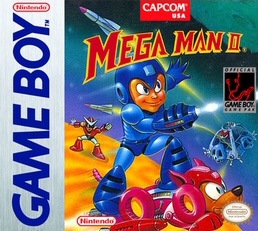
Mega Man II is an action-platform video game by Capcom for the Game Boy. It is the second game in the handheld version of the Mega Man series after Mega Man: Dr. Wily's Revenge. It is noteworthy for having been developed by a different company than the rest of the Mega Man titles on the Game Boy.
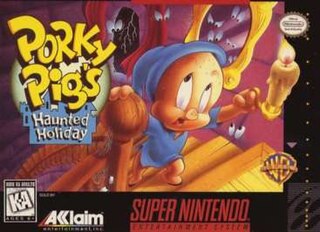
Porky Pig's Haunted Holiday is a 1995 side-scrolling platform video game developed by Phoenix Interactive Entertainment and published by Sunsoft for the Super Nintendo Entertainment System video game console. The goal of the game is to guide the main character, Porky Pig from the Warner Bros. cartoons, through his nightmares. The game received mixed to positive reviews by critics; its graphics and animations were received well while its length and easy difficulty were not.

Sunman is an unreleased action video game developed by EIM and planned to be published by Sunsoft for the Nintendo Entertainment System in 1992. Despite being mostly complete, it was never commercially released.

Ripple Island is an adventure game developed and published by Sunsoft. The game was only released in Japan on January 23, 1988 for the Family Computer.

The Wing of Madoola is a 1986 action-platform video game developed and published by Sunsoft for the Family Computer. It stars Lucia, a magic-wielding warrior of the Rameru clan. Darutos, a descendant of the Rameru line, found the Wing of Madoola statue and used it to build a demonic fortress and summon demons to conquer the world. Lucia must retrieve the statue and stop Darutos. Throughout the journey, the player explores and search for items and power-ups to increase Lucia's attributes, while fighting enemies and defeating bosses.
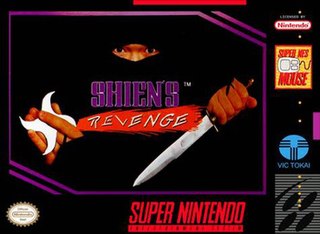
Shien's Revenge is a 1994 rail shooter video game developed by Almanic Corporation and originally published by Dynamic Planning for the Super Nintendo Entertainment System in Japan and later in North America by Vic Tokai. In the game, players assume the role of the titular ninja to fight against monsters coming from a time portal in order to face against an entity known as Undertaker and rescue his companion Aska. Co-designed by Takashi Shichijo and mangaka Go Nagai, the title was created by most of the same team that worked on previous projects at Almanic such as E.V.O.: Search for Eden. It was met with mixed reception from critics since its release.
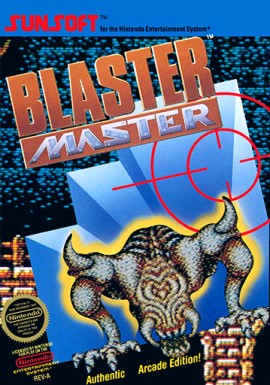
Blaster Master is a platform and run and gun video game released by Sunsoft for the Nintendo Entertainment System. It is a localized version of a Japanese Famicom game titled Chō Wakusei Senki Metafight, which was released on June 17, 1988. The game was released in North America in November 1988 and in Europe on April 25, 1991. The game is the first in the Blaster Master series, and it spawned two spin-off games as well as two sequels.





















